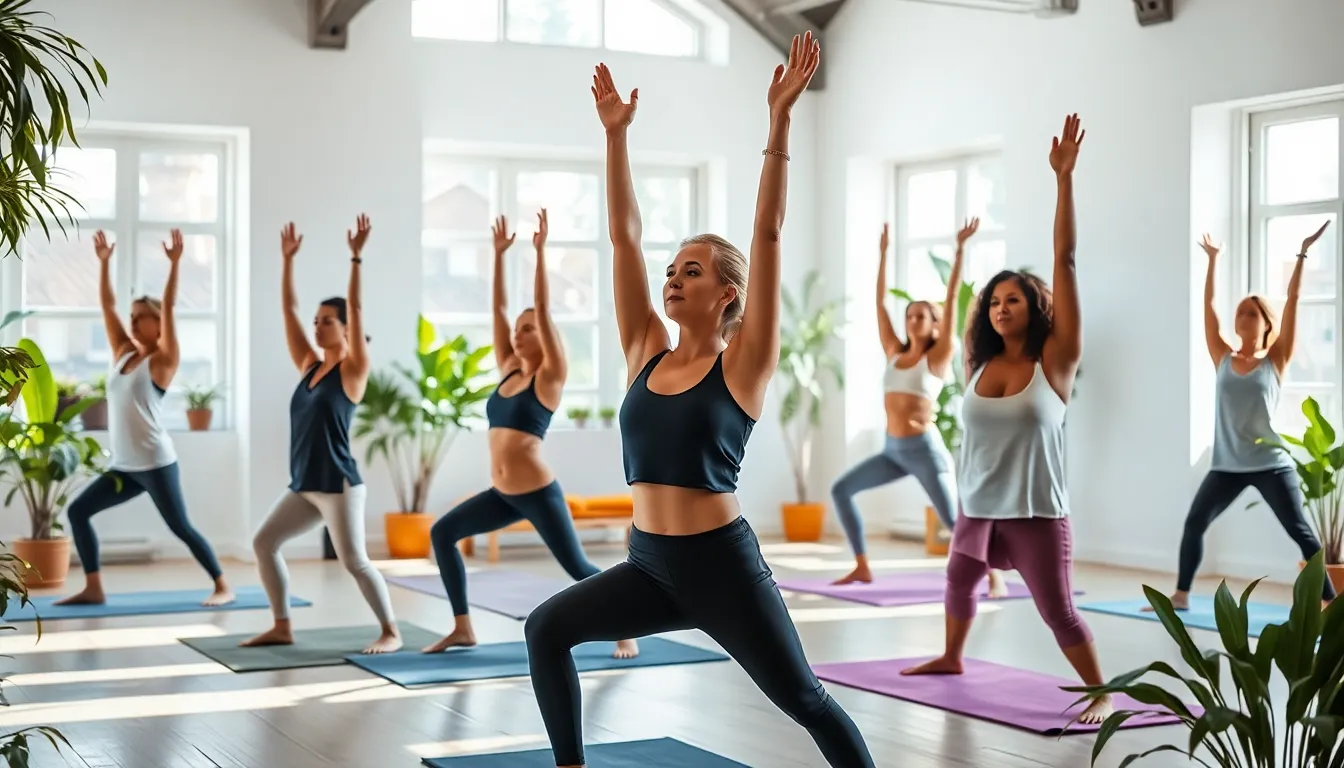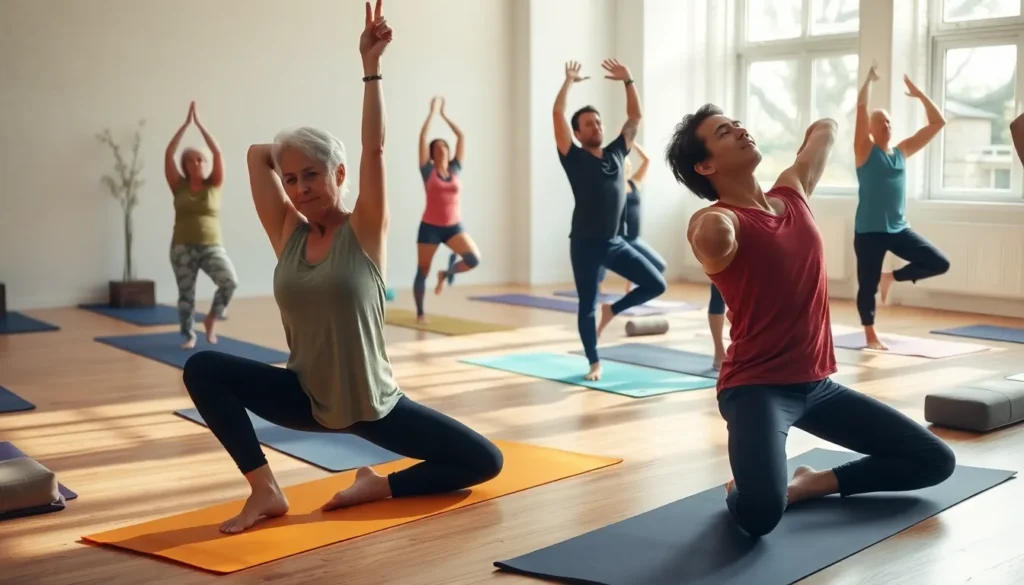In a world where stress seems to be the only constant, yoga classes offer a blissful escape. Imagine bending like a pretzel while your worries melt away. Whether it’s mastering the downward dog or simply trying not to fall over in tree pose, yoga is more than just a workout; it’s a way to find balance in the chaos of life.
These classes cater to everyone, from the seasoned yogi to the absolute beginner who might still be figuring out which end of the mat is up. With a mix of laughter, community, and a sprinkle of zen, yoga classes transform the mundane into the extraordinary. So why not roll out that mat and join the fun? After all, who wouldn’t want to stretch their body and their sense of humor at the same time?
Table of Contents
ToggleOverview of Yoga Classes
Yoga classes offer diverse experiences that combine physical movement, breath control, and mindfulness. Styles include Hatha, Vinyasa, Ashtanga, and Yin, each catering to different needs and preferences. Beginners often benefit from Hatha classes, which introduce foundational poses and techniques, while experienced practitioners can explore the dynamic flow of Vinyasa.
Class durations vary, typically ranging from 60 to 90 minutes, providing flexibility for different schedules. Community is a crucial element in yoga classes; participants often share spaces that encourage connectivity and support. Instructors guide sessions, ensuring participants practice safely and effectively, regardless of their skill levels.
Many studios prioritize inclusivity by offering sessions tailored to specific demographics, such as seniors, prenatal students, or those with physical limitations. Workshops enhance the learning experience, providing in-depth explorations of specific techniques, philosophies, or holistic practices related to yoga.
Participation in yoga classes promotes physical well-being, enhancing flexibility, strength, and balance. It also serves as a stress relief tool, facilitating mental clarity and emotional stability. Studies confirm that consistent attendance in yoga can lead to improved mood and reduced anxiety levels.
With numerous options available, individuals can find classes that resonate with personal goals and preferences. Exploring local studios or online platforms opens avenues for learning and engagement. Each class presents a new opportunity to deepen practice, connect with others, and enhance overall well-being.
Benefits of Yoga Classes


Yoga classes offer numerous benefits that enhance both physical and mental well-being. Participants experience a holistic approach to wellness, integrating movement, breath, and mindfulness.
Physical Benefits
Yoga improves flexibility significantly. Each pose stretches various muscle groups, leading to increased range of motion. Strength also receives a boost, as many poses require supporting body weight. Core stability benefits from consistent practice, enhancing overall posture. Balance improves, which is crucial for daily activities and reduces injury risks. Regular attendance in classes helps maintain these benefits, promoting long-term physical health. Participants often notice improvements in breathing efficiency, which contributes to better cardiovascular health. Overall, these physical enhancements create a stronger, healthier body.
Mental Benefits
Yoga fosters mental clarity through mindfulness techniques. Mindfulness encourages individuals to focus on the present, reducing distractions. Stress relief becomes evident as tension dissipates during sessions. Enhanced mood is a common effect, resulting from the release of endorphins during practice. Anxiety often lessens, as strategies from yoga help individuals manage stress. Improved concentration develops over time, supporting better decision-making and productivity. Many participants report a greater sense of community, which contributes positively to mental health. Overall, regular participation nurtures a resilient mind.
Types of Yoga Classes
Yoga classes encompass various styles, each tailored to meet diverse needs and preferences. Here’s an overview of popular types of yoga classes.
Hatha Yoga
Hatha Yoga offers a gentle introduction to yoga for beginners. Classes emphasize basic postures and breathing techniques, allowing individuals to develop foundational skills. Each session typically lasts 60 to 90 minutes, providing ample time for learning and practice. Participants focus on alignment, breath control, and meditation, which cultivate mindfulness. Many practitioners appreciate Hatha for its slower pace that encourages relaxation and self-discovery.
Vinyasa Yoga
Vinyasa Yoga is characterized by fluid movement and dynamic transitions between poses. Participants often synchronize their breath with each movement, creating a rhythmic flow that energizes the body. Classes typically vary in intensity, offering options from moderate to vigorous workouts. The continuous motion fosters increased strength and flexibility. Instructors may include creative sequences, ensuring variety and engagement throughout each session. This style attracts individuals seeking a more active practice with a focus on cardiovascular benefits.
Restorative Yoga
Restorative Yoga focuses on relaxation and recovery, making it ideal for stress relief. Classes use props like blankets and bolsters to support the body in gentle poses, minimizing strain. Each pose is held for several minutes, allowing deep relaxation and release of tension. Participants experience rejuvenation through breath awareness and mindfulness techniques. Many find this practice beneficial after rigorous workouts or during stressful periods in life. Classes create a serene environment, enhancing overall well-being.
Choosing the Right Yoga Class
Selecting an appropriate yoga class enhances the overall experience. Understanding personal goals is essential for this process.
Skill Level
Beginners may find Hatha Yoga particularly welcoming as it focuses on foundational postures and breathing techniques. Experienced practitioners often prefer Vinyasa or Ashtanga, which provide challenging sequences and dynamic movements. Intermediate yogis might opt for classes that introduce more complex poses and offer variations. Assessing skills before attending classes helps ensure comfort during practice. Many studios provide clear descriptions of skill levels for each class, aiding in the decision-making process.
Class Environment
The ambiance of a yoga studio influences the overall experience. A calm, supportive environment fosters relaxation and mindfulness. Studios often emphasize community, encouraging connections among participants through shared experiences. Class sizes vary, impacting the level of personalized attention instructors can offer. Smaller classes typically allow instructors to provide tailored adjustments based on individual needs. Inspecting the studio’s values regarding inclusivity and support can also contribute to a positive experience.





